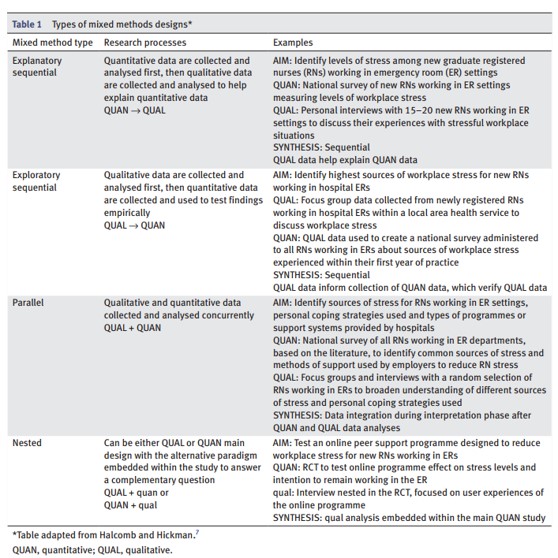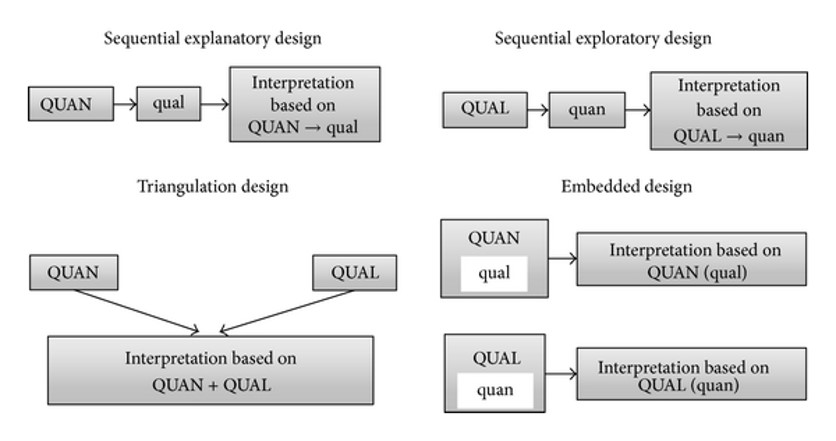Mixed Methods
Phylosophical Distinctions
Quantitative
- Based on positivism
- truth
- objective reality that exists independent of human perception
- investigator doesn’t influence phenomena being studied
- large sample sizes
| Strengths | Weaknesses |
|---|---|
| Ability to generalise findings when based on a random sample and a sufficient sample size | As focus is on theory and hypothesis testing and not generation phenomena may be missed |
| Data collection and analysis can be relatively quick and is often more prescribed | Research categories for data analysis may not reflect the wider community feelings |
| Provides numerical data and often considered to be more precise results | Knowledge produced may be to general |
| Can allow for confounding influences on variables to be eliminated and cause-and-effect relationships to be researched | May not always provide contextual detail which can impact results |
Qualitative
- Interpretivism and constructivisism
- multiple realities – socially constructed
- investigator shapes the enquiry
- emphasis on process and meanings
- samples not meant to represent large population
| Strengths | Weaknesses |
|---|---|
| Provide opportunity to describe in detail phenomena situated and embedded within local contexts | Is more difficult to test theories and hypothesis |
| Allows a researcher to study dynamic processes | Data collection and analysis can be more time consuming |
| Useful for helping to describe more complex phenomena | Knowledge produced is not always generalisable to different populations and settings |
| Can help to explain how participants explain and interpret ‘constructs’ (e.g. self-esteem) | Results/analysis can be influenced by the researchers biases and beliefs |
Data Definitions
Hard Data
“Hard data” is generally described with some specificity…it is usually quantified…
Statistical information is the most common form of hard data. Statistics can be persuasive and lend an air of validity to reports.
Not always what they seem:
- e.g. there is a statistically significant relationship between going to bed with your shoes on and waking up with a headache….
- e.g. there is a statistically significant relationship between eating ice-cream and drowning….
Soft Data
“Soft data” is anecdotal, usually gathered in informal communications
Can be considered to lack the rigour that is implied in statistical data.
Can explain the numbers
It relates to people’s opinions or feelings – things which can be difficult to measure
Soft data in the form of quotes and anecdotes, adds context – peoples experiences….
- “..so I started behind in year 7 – there was no extra help and I could keep up as long as I got on with the teacher, but with the others I’d go home. It‘s the teachers’ fault – one always called me Moneypenny and that’s not my name”
- “I didn’t know what to do and I couldn’t read. The teachers didn’t like me and I didn’t like them”
Combining Research Methods
Mixed Methods Research
Lots of definitions (see pages 119-121)
“Mixed methods research is the type of research in which a researcher or team of researchers combines elements of qualitative and quantitative research approaches (e.g., use of qualitative and quantitative viewpoints, data collection, analysis, inference techniques) for the broad purposes of breadth and depth of understanding and corroboration.” Johnson, Onwuegbuzie & Turner 2007 p.123
Complexity in Public Health
Rychetnik et al. (2002) highlight how “public health interventions tend to be complex, programmatic and context dependent” (p119).
We need to be aware that complex behavioural interventions comprise a number of different components which may “act both independently and inter-dependently” (MRC, 2000, p2) with the aim of producing the desired behaviour change.
Mixed methods in health science research
Mixed-method research has become a popular paradigm due to its ability to potentially provide “the most informative, complete balanced and useful research results” (Johnson, Onwuegbuzie & Turner, 2007, p129).
It is gaining popularity (Johnson, 2019) - https://www.ncbi.nlm.nih.gov/pmc/articles/PMC6448508/ - “The growth of MMR reflects the complexity of health-related research questions including the need to understand stakeholder perspectives”.
Why Use Mixed Methods Research
- Can allow us to answer more complex questions
- Can help to develop more meaningful surveys based on qualitative methods
- Allow a rich level of detail to be obtained form some of those in the sample
- To gain confirmation through the combining of outcomes.
- When to Use Mixed Methods (Video)
- The Value of Mixed Methods Research: A Mixed Methods Study
Characteristics of Mixed Methods Research
On the whole a researcher uses a core method (e.g. Qual or Quant) but adds data collection strategies from the other remaining method (e.g. Qual or Quant) to aid the answering of the research question.
- E.g. Qual + quant or Quant + qual
There may be instances where a equal weighting design is used
The core method is determined by the theoretical perspective relating to the research questions
Philosophy in mixed methods research
Rather than challenges the worldviews associated with quantitative (positivist/empiricist) and qualitative (interpretivist/constructivist), mixed methods draws on the philosophical approach of ‘pragmatism’.
An oversimplified explanation of pragmatism is that humans use scientific knowledge to explain changing natural and human conditions (Peirce, 1878; James, 1907, 1909; see also, Greene, 2007; Pluye & Hong, 2014, cited in NIH Office of Behavioural and Social Sciences, 2018, pg 7)
Overview of Pragmatic View
| Term | Definition |
|---|---|
| Methodology | Mixed-method |
| Ontology | Multiple ways of viewing, hearing and understanding the world |
| Epistemology | Knowledge is formed by objective and subjective value. |
Strengths of Mixed Methods Research
- They share the goal of understanding the world we live in, and share a unified logic
- Compatible – both have theoretical underpinnings – and have the goals of improving ‘the human condition….disseminating knowledge for practical use, and a shared commitment for rigour conscientiousness, and critique of the research process’ (Reichardt & Rallis, 1994, cited in Sale et al., 2007, pg 46)
- Useful – because complex phenomena need data for different perspectives – e.g. Public health problems ‘epistomological purity’ does not get research done! (Miles & Huberman, 1984, cited in ibid, pg 46)
Mixed Method Designs

Mixed methods research: expanding the evidence base
Typical Methods Used
Figure 3: Illustration of four major mixed methods designs. Key: QUAN indicates quantitative component; QUAL indicates qualitative component. CAPITALS indicate component is typically emphasised or prioritised in this design. Lower case indicates component is typically used in a supportive capacity. Based on Creswell and Clark [8].

Example of Mixed Method Designs
| Sequential | Concurrent | |
|---|---|---|
| Dominant + Less Dominant | QUAL → quant Qual → QUANT QUANT → qual Quant → QUAL | QUAL + quant QUANT + qual |
| Equal Weighting | QUAL → QUANT QUANT → QUAL | QUAL + QUANT |
Types of Methods
| Quantitative research | Qualitative research |
|---|---|
| Data collection e.g. questionnaires, secondary data, medical records, checklists etc | Data collection e.g. interviews, focus groups, observations, secondary data, audio-visual etc |
| Analysis e.g. descriptive, interpretation, related variables etc | Analysis e.g. themes, framework analysis, coding etc |
Validity and Reliability of Research
- Creswell & Clark (2011) write that within quantitative research validity takes two levels in relation to quality of the scores and the conclusions drawn from the results (i.e. are the scores meaningful indicators of what was being measured).
- Qualitative validity Creswell & Clark (2011) relate this concept to whether the findings are accurate, trustworthy and credible.
- Unlike the more accepted ways within quantitative research to determine validity, within qualitative research there are a number of methods e.g. member-checking of findings by participants, triangulation with other methods and multiple researchers conducting the same analysis.
- Within a mixed-method design the use of triangulation can also explore the accuracy of information across different sources.
Things you may need to consider…
- Is it suitable or necessary to use mixed methods?
- Requires being more comfortable with more research methods
- Is more time consuming and can be harder to analyses
- Why is just using qualitative or quantitative methods not suitable
- What data do you need to answer your questions and what methods are suitable to collect this?
- Why do you want or feel you need to carry out the study in a mixed methods way?
- What mixed methods design is the most suitable?
- Useful to work through
- May have a larger sample for the quantitative part than the qualitative part
- Need to think how you will sample participants for each part e.g. self selection or purposive sampling
- When will you carry out each section, how long with people wait between stages or be needed in total
Limitations in MMR
- They increase the complexity
- They often require more researchers or at least more skills around research methods for a researcher
- They require more time and resources
- They are not suitable for all occasions